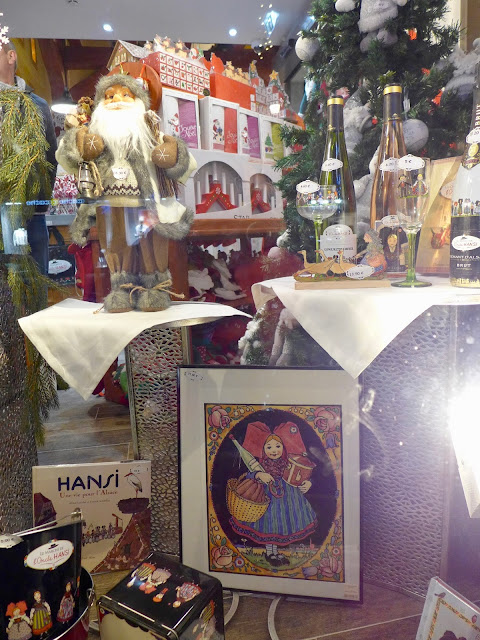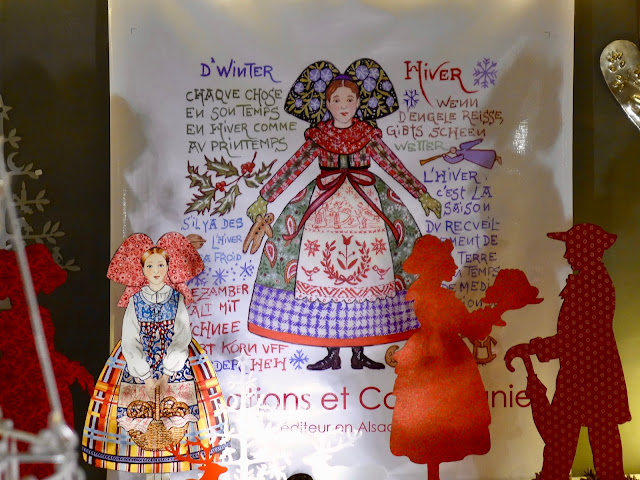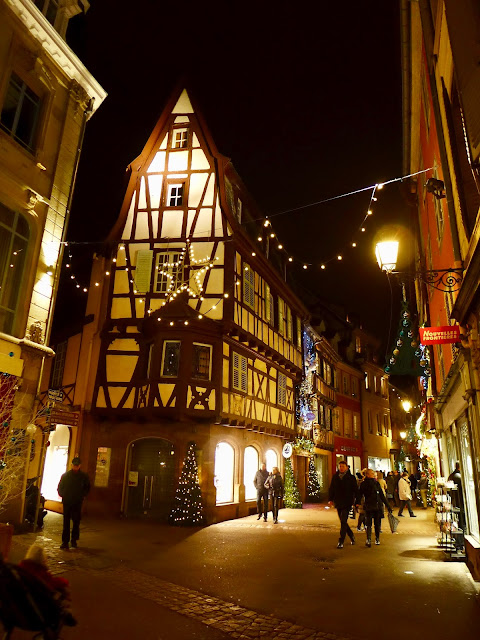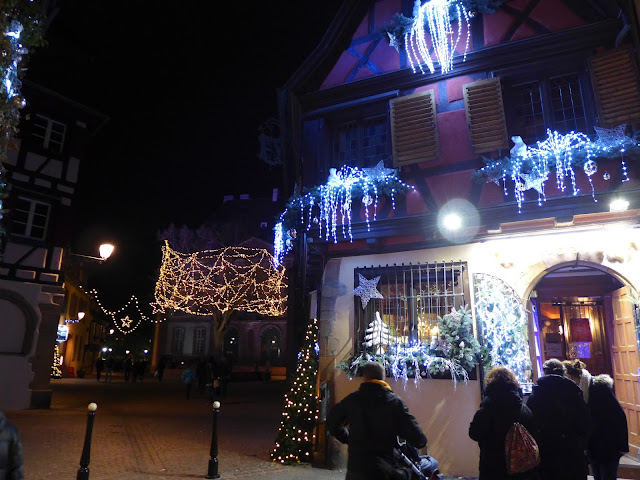My daughters and I just love going to Christmas markets. Its the warm and Christmas fairytale atmosphere that we enjoy. So, off we went to another Christmas market, after spending a day at the "Christmas Capital of France" - Strasbourg. By train, we headed to Colmar: The Land of Christmas Stars
Colmar is the 3rd largest city in Alsace. It is 40 miles southwest of Strasbourg. Its history on how she acquired Germanic and French influences is very similar to that of Strasbourg. The town is on the Alsatian wine route and is the "capital of Alsatian wine."
In Colmar, it is said that one can experience the magic of Christmas. The historic part of town is illuminated and decorated, making the ambiance in the old town so festive. Among the discoveries here are the architectural treasures of churches , museums, and structures dating back to the medieval ages. And not to be missed are the regional foods and the artisanal crafts.
From walking the picture-perfect streets of Colmar at this time of this year, we could see how the description that Colmar is "The Land of Christmas Stars" is most fitting.
November 25 to December 30, 2016
Welcome to Colmar this holiday season!
ARCHITECTURAL HERITAGE
There are Germanic and French influences in the architectural history of Colmar that have been adapted to the traditions and the culture of the local population. Prominent is the use of yellow and pink sandstone bricks from the Vosges mountains, and the timber-frame construction.
Egise Saint-Martin
The collegiate Church of Saint Martin is an example of Gothic architecture in Alsace, constructed between 1235 and 1365. The south tower was destroyed by a fire in 1572, also damaging the framework and the the whole roof. Three years later, the roof was reconstructed with the original design of the lantern bulb - a dome constructed in the form of a lantern, giving it back its former silhouette. In the last restoration in 1982, traces of the foundation of a church going back to the year 1000 , and extensions made in the 11th and 12th centuries were discovered.

For the people of Colmar, they consider the St. Martins collegiate church as their cathedral. A collegiate church is one that has been given a "chapter of canons but without a bishop's see." This is because the two constitutional bishops who followed one another from 1790 to 1801 were not able to organize a diocese. A constitutional bishop was a Roman Catholic bishop who was elected among the clergy and sworn to follow the Civil Constitution during the French Revolution.
*********
Built in 1537, for the hatter Ludwig Scherer, with medieval features, this house exemplifies architectural renaissance in Colmar. The family lived in this two-storey house, with a corner oriel window, a wood gallery, an octagonal turret with mural paintings with biblical themes, from 1841 to 1892.
*********
The name, Petite Venise (Little Venise), came from the houses on both sides of the river, in the southeastern part of the city, from the Koïfhus, through the fishmonger's district, and to the bridges Turenne and Saint-Pierre. it is at the beginning of the Krutenau, which were the places of market gardening on the outskirts of towns. It was inhabited by rural wine-producers, market gardeners and boatmen.
In the warmer months, boat rides are offered on the waterways.
*********
This is where the professional fishermen and boatmen lived, composing a powerful corporation. The fishes they caught were stored in fish ponds or sold directly from the fishmonger's district. This area was restored from 1978 to 1981 after a fire destroyed more than 40 homes. The half-timbered houses from the Tanners district and Little Venice were restored to how they were, then.
***********
TIMBER-FRAMING ARCHITECTURAL STYLE
Timber- framing or half-timber construction is a building method, wherein, external and internal walls are constructed with timber frames, and the spaces between the wooden structures are filled with materials like bricks, plaster, or wattle and daub.
Wattle and daub is a a building material for making walls, in which wooden strips are woven to form the wattle, is daubed with a sticky material made by combining wet soil, clay, sand, animal dung with straw. This is making a comeback as a sustainable building technic.
*********
AT THE COLMAR CHRISTMAS MARKET
Christmas Market - Place des Dominicains
There are sixty Christmas huts that offer decorations, fashion accessories, and food specialties from the region in this market.
Our daytime walk around the Christmas market at Place des Dominicains
On our way back to the Christmas market by the Dominicain church
With the Dominican Church in the background, the stained glass from the 14th century, lit from within, was a beautiful addition to the Christmas market setting.
How the market ambiance changes from day to night.
*********
Christmas Market - PetiteVenise
This market was designed as a child's kingdom for the young and old. There are 43 cottages beautifully decorated, with treasures to admire or buy. Kids can write and post their letters to Santa in a giant postbox.
The animated Nativity display
*********
Christmas Market - Place Jeanne d'Arc
This is a recreation of an Alsatian village, offering Alsatian culinary finds - foie gras, charcuterie, Christmas cakes and cookies, and more. And, vin chaud or mulled wine to help keep warm.
This lady attracted a lot of attention, as she was the only one dressed for the Christmas market in a traditional Alsatian outfit.
*********
Christmas market - Place de l'Ancienne Douane
Fifty Christmas stalls are arranged here, near the fountain of Schwendi, which extends along the river. Koïfhus, which houses the artisan vendors is not far from here.
*********
Handicraft Christmas Market - At the Koïfhus
This is the old custom house, a medieval building, where 20 local artisans - ceramists, potters, glassmakers, cabinetmakers, woodworkers, hatters, jewellers, patissiers, etc., - are showcasing their products.
The Toy Museum of Colmar set up this winter mountain-village electric train display.
The view below from the Koïfhus
A display by a patissier -
a gingerbread-house winter village.
*********
Christmas Tree Market
Varieties of Christmas trees, advent wreaths, and Christmas ornaments are available - all you need to create an Alsatian Christmas ambiance in your homes.
Artisanal-type Christmas ornaments, made by crafters
Christmas globes with wintry scenes, Christmas figurines,
and stuffed toy ornaments
Versions of le Père Noël (Father Christmas, now better known as Santa Claus in the west)
*********
GOURMET HOLIDAY TREATS FROM ALSACE
When family and friends gather together during the holiday season in Alsace, there is usually a table spread of gourmet, Alsatian delicacies to feast on. We, too, can experience a bit of this as we go around the Christmas market.
WARM BEVERAGES
The scent of hot mulled wine with aromatic spices fills the air. This is a blend of white and red wine, with added honey, sharp flavors of lemon and orange, and spices like cinnamon, aniseed, nutmeg and cloves, the perfect accompaniment to Bredele cookies.
The non-alcoholic drink for the kids: jus de pomme chaud
At the Christmas market, the big people walk around sipping mulled wine, and for the kids, they can enjoy their own warm beverage, too - an alcohol-free apple or orange juice. These warmed drinks are so perfect during the cold winter nights, especially, when the blustery wind blows at your face.
BREDELES
Bredeles are sweet, small, dry-cookie delicacies served as snacks around the Christmas tree or the Advent wreath. These cookies are prepared with cinnamon, orange, aniseed, chocolate and walnuts or almonds. In the market, you can buy and sample the cinnamon stars, butterbrele with butter, anisbredele dusted with aniseed, schwowebredle with almonds, spriyzbredle with lemon peel. They are sold by weight or packed in small cellophane sachets.
GINGERBREAD CREATIONS
Gingerbread is very popular. They come in different shapes, sizes and flavors. Some are simply cut into little diamond pieces, coated with a light sugar icing, with ginger or dried fruit. These specialties are made with flour, honey and spices and are a traditional symbol of an Alsatian Christmas celebration. Gingerbread is typically served on the feast of Saint Nicholas.
Among the fabricators of these Alsatian gingerbread varieties are Palais du Pain d'spices of Maison Fortwenger and Maison Lips Musée du Pain d'spices et des Douceurs d'Autrefois (Museum of Gingerbread and Delicacies of Yesteryear).
CHRISTMAS BEERS
In the Middle Ages, it was the monks who prepared a strong, malt-rich beer for the Christmas season. Now a days, it is the breweries that produce the beers, all in keeping with the tradition of producing special-edition beers at this time of the year. The Christmas beers have aromas of cinnamon, honey and ginger, and best served chilled between 10° to 12°. When you take a swig of beer, you are reminded to take it in moderation. The beer goes well with the regional spcialties of the season.
FOIE GRAS
Foie gras has been a staple on the table when celebrating a French Christmas, since the 17th century. The foie gras' rich, creamy taste - made from duck or goose liver, is best suited with a serving of the Alsatian wine produced in the region.
 White and red wine from the Alsace region
White and red wine from the Alsace region
It is not just in the food, but in the decorations, as well, are the flavors in their culinary Christmas specialties used, like in a fresh-pine wreath, Advent wreath, or swag decorated with sliced, dried oranges and tangerines or other fresh fruits and some nuts.

Imagine all the aromas from the spices and fruit ingredients, some roasted nuts, permeating the air, which all add to the warmth of creating an Alsatian Christmas for the big celebration!
*********
WALKING THE LOVELY STREETS OF HISTORIC COLMAR, IN CHRISTMAS FINERY
Christmas is just around the corner and we have brought back some of the Alsatian specialties and practices to bring some of the ambiance from here to our home.
Related Articles:



















































































































